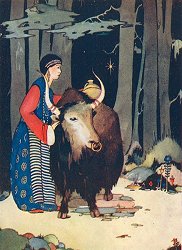“The Story of the Two Devils”
Today’s folk tale comes from Tibet, a land whose stories I am completely unfamiliar with.
A long time ago, there was a plateau high in the mountains on which were situated several cites, all ruled over by a king with seven sons. One day, when the sons were playing in the forest, they found a beautiful girl who was herding a yak. “The seven sons thought that she was very pretty to look at, so they proposed to her that she become the wife of the seven, which was the custom of the country.” (pg. 70) The girl consented and went home with the brothers, bringing her yak along.
Every year, one of the brothers died, starting with the oldest until only the youngest was left. He of course became very ill and the head-men of the villages decided to send for a fortune teller. The fortune teller they chose may have been a fake, but he does come up with a plan. Through his help, it is discovered that the girl was actually a she-devil and the yak her husband.
The yak turned at once into a he-devil with a hideous face, two of his upper teeth hanging down to his breast and two lower ones extending up to his forehead. The men standing around killed him with their swords and guns. Then the fortune teller called for the woman to come. She came screaming, and he struck her with the hog’s skull and she turned into a terrible thing, with a most ugly face, clawlike hands, a great long tongue and teeth like her husband’s. The people killed her with rocks and knives and burned them both in the fire; then hastened to do great honor to the fortune teller, who had gone back to the sick man. (pg. 73-74)
Of course the fortune teller is rewarded, although his wife asks for more. Instead of seeing this request as an insult, the surviving son makes the fortune teller ruler of half of the kingdom.
Unlike most of the fairy tales and folk stories we’ve read, the beautiful girl is not as kind and innocent as she is lovely. Physical beauty can be only skin deep and can hide pure evil, not a bad lesson in any time or place.
I’ve said before that stories from other cultures can teach us about those people. In the story, the girl marries all the brothers, which struck me odd. Of course, I know that polygamy exists and has existed for umpteen centuries but I always associated it as a man having multiple wives. Apparently, and this based on a very quick internet search so if I’m wrong please let me know, polyandry, where a woman marries multiple men most often brothers, was historically practiced in Tibet and a few other regions. It did provide several benefits- economic stability and security for the woman, lots of men to work the fields, strong family ties. Anyway, that’s the bit of knowledge I gained today.
I read “The Story of the Two Devils” on-line here, but it can be found in Tibetan Folk Tales by A. L. Shelton.
 Tif, from Tif Talks Books, is the hostess of this great feature, Fairy Tale Fridays. Head over there to see what she has to say about another Tibetan tale, “Chunda’s Wisdom Quest,”and to share your own thoughts. Next week, we’ll be looking at a Russian tale.
Tif, from Tif Talks Books, is the hostess of this great feature, Fairy Tale Fridays. Head over there to see what she has to say about another Tibetan tale, “Chunda’s Wisdom Quest,”and to share your own thoughts. Next week, we’ll be looking at a Russian tale.


Lol, the only thing I had to say was yay Tibet, good for women to get many husbands and not only men to get many wives
Sorry for being so late in posting, but it is now up and ready! I actually made a change to the schedule for next week and the week after, but feel free to stick with your choice next week since I was so late in announcing it this time!
I’m really intrigued by this story! I was unfamiliar with Tibetan tales as well and I am really curious to read more of them, especially since you have mentioned polyandry! It brings up so many questions . . . Is Tibet a matriarchal society? How does this affect the religious beliefs? I will leave it at that though because I really could go on and on!! 🙂
blodeuedd – on the other hand, I don’t know if I could handle multiple husbands. One takes a lot of energy sometimes.
Tif- no problem with the schedule change. This story really did make me curious about Tibetan culture.
Thanks for letting me know about this one. Been reviewing Tibetan books every month so this is a nice little peak into the culture. Polyandry exists even today in Tibet. It’s not as wide spread as it was in the past, it’s function is primarily to keep from dividing the wealth of a family: completely on a economic basis.
Great review!
PK
PS Inside scoop… I’m Tibetan 😉
Aisle B – Thanks for the comment. Like I said, Tibetan culture is something I’m totally unfamiliar with.